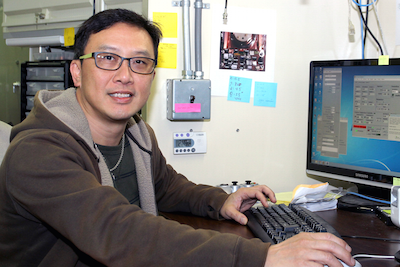 Cobber Lam started working at Berkeley Lab 10 years ago as a student assistant, while attending college at Cal State East Bay. Within two months, he was assigned to the ALS and has stayed put ever since. He used to be matrixed via IT, but last year he became a direct ALS employee. ALS IT support is divided between Lam and Tim Kellogg, with Lam being more forward-facing, dealing with users and staff, and Kellogg working on the back-end mostly with controls and operations groups.
Cobber Lam started working at Berkeley Lab 10 years ago as a student assistant, while attending college at Cal State East Bay. Within two months, he was assigned to the ALS and has stayed put ever since. He used to be matrixed via IT, but last year he became a direct ALS employee. ALS IT support is divided between Lam and Tim Kellogg, with Lam being more forward-facing, dealing with users and staff, and Kellogg working on the back-end mostly with controls and operations groups.
What’s a typical day like for you?
My first priority is the beamlines; beam time is expensive and we need to make sure those beamline computers are running 24/7. Other than that, its mainly “break and fix.” On the side there’s always regular maintenance—new software, hardware, IT infrastructure maintenance, virtual machine maintenance. Sometimes I’m up and running all day, sometimes I’m stuck in a back room fixing a computer all day. My peak day was last year, when I logged 22,000 steps and 20 stories on my Fitbit. My average is more than 10,000 steps a day.
What do you enjoy most about working at the ALS?
Everyone is so nice, and I’m never bored.
What’s challenging about working at the ALS?
It’s such a unique environment. The beamline computers are non-standardized, so there’s always something specialized about each setup. On the user side, computers are more or less standardized. The skillset you need here is not the same as in a corporate environment where everyone has the same setup, same software. Everyone here is very smart, so I find that a lot of the problems they present to me are really challenging. By the time they call me, they’ve often already done some pretty smart trouble-shooting.
Another issue is staying on top of hardware development for storage needs; scientific research accumulates a lot of data!
I really have to know my customer base; I am always prioritizing tasks and have to know who needs me immediately, and who can wait.
Have you always been interested in computers and hardware?
Oh yeah, when I was a kid none of my toys survived. I was always too interested in taking them apart to see what was going on. When I was a bit older, building computers became my hobby. It was cheaper back in those days to buy the parts and build your own. I would say that I learned the most about computers before I even went to college.
How do you keep up with industry trends and advances?
I read a lot of tech websites and blogs, some daily. The ones I read the most are ArsTechnica.com, AnandTech.com, and blogs.technet.com. It’s really important that I know what’s available so that when someone presents you with an issue you can tell them what options they have and what would work best. We are always being called upon for consultation.
What do you like to do in your free time?
My main passion earlier in life was fine art photography—initially I thought I’d go to school for photography and become a photography teacher—and I still really enjoy it. I carry my camera with me everywhere.
Other than that I really love to go camping, hiking, and I like to eat and have friends who are amazing cooks and enjoy cooking for me! One of my favorite local hiking spots is around Lake Chabot.
I’ve gotten used to the “glamorous” way of car camping; I usually go with a group of friends and everyone shares the cooking. Having grown up in Hong Kong, camping was taking a bus out to the countryside, getting dropped off on the side of the road and hiking for hours before making your own camp. Pretty different!